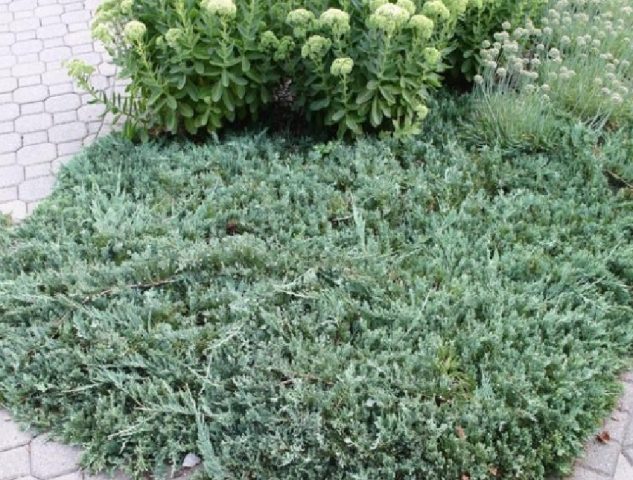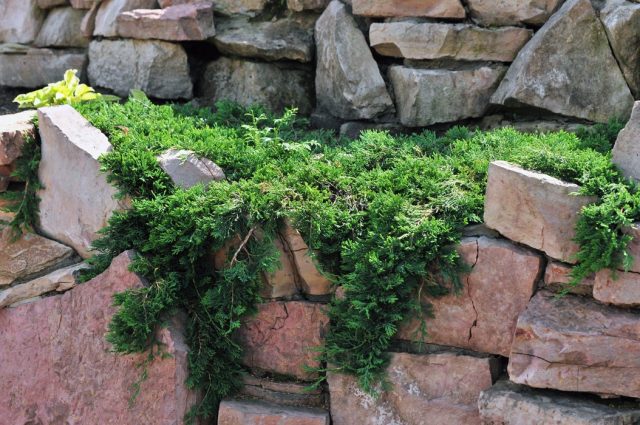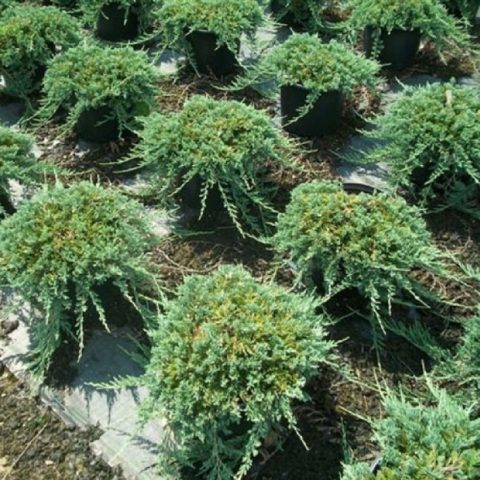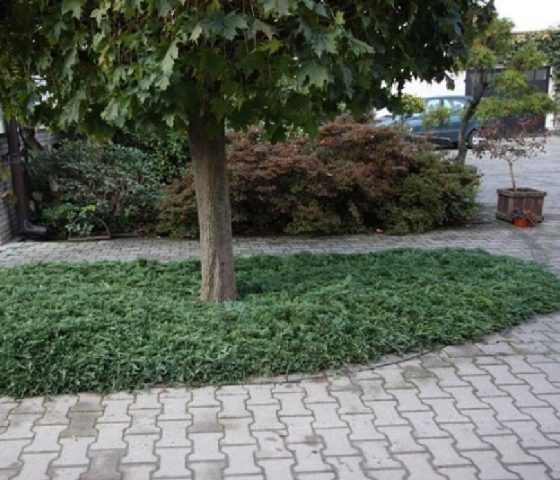Content
Wiltoni's evergreen juniper is a very scenic dwarf shrub. Creeping forms always attract attention with their unusual characteristics. Wiltoni is used not only in landscaping projects for decorating plots, but also for practical purposes by gardeners. The unpretentiousness and beauty of the juniper attract the attention of creative designers.
Description of horizontal wiltoni juniper
It is believed that Wiltoni's homeland is an island called Vinal Naveen Maine. In 1914, the plant was discovered by J. Van Heinigen, a resident of southern Wilton, Connecticut. The Latin name for the horizontal Wiltoni juniper is Juniperus Horizontalis Wiltonii.
The plant is very original. Its height, as in the main horizontal varieties, is no more than 20 cm, but the length of the branches reaches 2 m. This is an unusual characteristic for dwarf junipers.
The crown is creeping, very dense, carpet-like. The branches are densely packed, an adult plant resembles a carpet in shape.
Another important advantage of Wiltoni is its fast growth. During the year, the branches grow 15-20 cm, while maintaining excellent flexibility.
Juniper bark is not highly decorative. It is grayish-brown in color, smooth, but slightly cracks into thin plates.
The needles are of a beautiful bluish-silvery color, do not lag behind the branches, but adhere tightly to them. There may be changes in hue from gray-green to blue-green in the summer months. In winter they resemble a lilac plum. The needles are small, no more than 0.5 cm, subulate, located very tightly on the shoot. If rubbed with hands, they exude a persistent aroma.
Branches are long, tail-shaped, have abundant growth in the form of short twigs of the second order. They grow slowly, spread on the ground in a star-shaped form, take root and intertwine with each other.
Forms blue cones. Diameter 0.5 cm, spherical, fleshy. The ripening period is about 2 years, however, when cultivated on the site, it may be absent.
The longevity of Wiltoni juniper is from 30 to 50 years.
Juniper Wiltonii in landscaping
The culture is used to decorate alpine slides or in the form of a juniper lawn. It goes well with stones of various shapes and sizes when creating rockeries or zoning. Combines Wiltoni with accent species - vertical junipers, bright deciduous or flowering shrubs, perennials.
Looks both in single landings and in group. Several Wiltoni junipers, planted side by side, give the impression of a dense array. Often gardeners prefer to plant Wiltoni juniper on a trunk, which gives a very original look to the composition.
The variety is ideal as a ground cover. Covers the ground well, inhibits growth weeds... Used like:
- element of a stone garden;
- decoration of terraces;
- greener for roofs, tubs and pots.
The photo shows an example of landscaping a site using horizontal Wiltoni juniper.
Planting and caring for Wiltoni juniper
A dwarf variety should be planted immediately to a permanent place - the plant is difficult to tolerate a transplant. Be sure to take into account the size of an adult plant. Viltoni grows well, he needs to leave enough space. Although some gardeners prefer to prune the branches regularly. The result is a lush, undersized plate. The horizontal Viltoni juniper is undemanding to care, but you need to know some of the nuances of growing.
Seedling and planting plot preparation
Wiltoni grows best on sandy loam or loamy soils. The reaction of the soil should be slightly acidic or neutral. The species grows well on soils with a sufficient lime content.
Novice gardeners are advised to buy container plants from nursery gardens.
Landing rules
When planting Viltoni, you should adhere to the recommendations:
- The composition of the soil mixture should be from sod land, sand and peat (1: 2: 1). We completely replace peat with humus in the same ratio.
- Prepare planting holes at a distance of 0.5-2 m, the size of which is 2-3 times the volume of the earthen coma. The depth of the pit is 70 cm.
- Lay a 20 cm thick drainage layer on the bottom. Broken brick, gravel, crushed stone, sand will do.
- Pour a small layer of soil mixture, install a juniper seedling. If the plant is in a container, do the transshipment, trying not to destroy the earthen lump.Important! The root collar must not be buried.
- Lightly tamp the ground, water Viltoni abundantly,
After planting, you can proceed to the stages of caring for the juniper. According to reviews, the horizontal Wiltoni juniper variety belongs to undemanding plants.
Watering and feeding
The main attention will need to be paid at the first time after planting the Wiltoni juniper. The land should not dry out, but stagnation of water is not allowed. During the period of active growth of the juniper, the irrigation schedule should be strictly followed. In dry months, moisten the soil at least once every 10 days. Watering is important, but Wiltoni is much more demanding on air humidity. Therefore, for the crown, you need to regularly sprinkle.
Top dressing for creeping species is applied in early spring, always adhering to dosages. For 1 sq. m, 35-40 g of nitroammofoska is enough.
As a result of an excessive increase in the nutrient content of the soil, the spread shape of the crown is lost.
Mulching and loosening
Loosening should be done not deeply and carefully, especially for young plants. It is more expedient to loosen the Wiltoni's near-stem circle after watering.
It is recommended to mulch the soil with peat, humus, straw or sawdust.
Trimming and shaping
Periodically, pruning is needed for horizontal junipers. When sanitary, dry and damaged branches are removed. If a formation is made, then all shoots that grow incorrectly are subject to removal. It is important to create a voluminous crown for Wiltonii, then the juniper takes on a very beautiful appearance.
The needles contain toxic substances, so it is recommended to trim with gloves.
Preparing for winter
Young plants, especially in the first year, need to be covered for the winter. Spunbond, burlap, spruce branches will do. As it grows older, the frost resistance of the Wiltoni horizontal juniper increases. Adult bushes winter well without shelter. Wiltonii can withstand temperatures as low as -31 ° C. The main thing is that the plant does not overwinter under a snowdrift. In adult bushes, it is advisable to collect and tie branches for the winter. And in the spring, cover the juniper from the sun's rays so that the delicate needles do not suffer.
Propagation of horizontal juniper Wiltonii
The species is propagated with the help of semi-lignified cuttings or layering.If Wiltoni is propagated by seeds, then varietal characteristics will be lost. Cuttings are harvested from late April to mid-May. To do this, choose a bush at the age of 8-10 years and cut off a stalk with a "heel". The length of the shank is 10-12 cm. Before planting, place the future juniper seedling in a growth stimulator solution. Plant in a nursery, cover with foil. Spray the ground periodically, provide diffused light, temperature + 24-27 ° С. After 1-1.5 months, the material will take root and can be planted in open ground.
Diseases and pests of creeping Wiltoni juniper
The main danger for the horizontal view is gray mold and fungus rust. Prevent spreading by maintaining the exact distance between the planted bushes. The second condition is that the juniper must be planted away from fruit trees. In the spring, carry out the treatment with copper-containing preparations.
Dangerous pests - scale insects, spider mites, shoot moths. In the event of the appearance of parasites, treatment with chemicals is necessary (according to the instructions).
Conclusion
Juniper Wiltoni is an original type of creeping conifers. With its help, you can decorate an inharmonious area, create a delicate and delicate lawn. The main advantage of the shrub is its unpretentiousness and the ability to develop well in urban conditions.
Reviews of Wiltoni juniper













